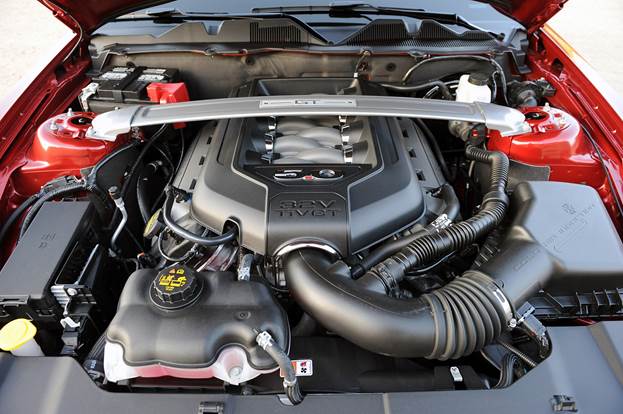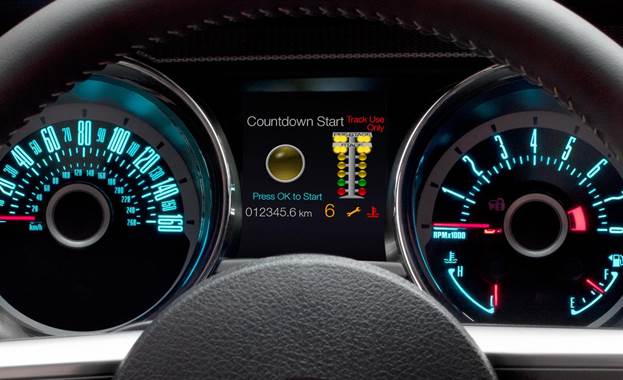Three years after the Mustang’s debut, Ford grants us 40,000 miles’ worth of GT. It was worth the wait.
We’d petitioned Ford for a long-term Mustang ever since the 2010 model made its debut. This fifth-generation Mustang felt like a reborn car, even if its solid axle is to automotive componentry what the polyester leisure suit is to modern menswear. The Mustang fully exploited its mix of new and old tech to win multiple comparison tests, knocking off higher-powered offerings from Dodge and Chevy in the process. Not insignificantly, it also collected three consecutive 10Best trophies (2011-2013).

The 2010 model floored us with its athleticism, especially when endowed with the optional Track package. We asked very nicely for a Boss 302 long-term tester, the best-handling model that is now discontinued. Protracted negotiations instead produced this 2013 “Deep Impact Blue” GT with the $2,495 Track package, which includes Pirelli P Zero summer tires, upgraded brakes, and a 3.73:1 differential of the limited-slip variety. By the time we’d spec’d our long-term pony, the GT’s 5.0-liter V-8 had gained eight horsepower, making for a total of 420, a number sure to amuse recreational weed enthusiasts.
Optional Recaro seats ($1595) complement the aggressive Track package and the aggressive Track package and have significantly more hindquarter-holding capability than the stock buckets. Showing uncharacteristic restraint, we passed on other pricey add-ons, such as navigation, automatic climate control, and the glass roof, but we did select the $4000. Premium package for its leather seats, satellite radio, and uprated stereo with Sync. Scandalously, the Premium pack and optional Recaro buckets can’t be paired to produce seat heaters, and the power-seat upgrade normally included in the Premium package isn’t included with the Recaros.

Two zero-cost options, stripe-delete and spoiler-delete, kept our blue coupe as incognito as possible, placating deputy editor Daniel Pund because he hates decklid aero accouterment. Except on Hyundais.
At $39,185, our GT was, on paper, as perfect for enthusiasts as the order guide would allow, and early logbook comments confirmed that the GT is a great everyday muscle car. Its power to pin passengers in the seats distracts from any refinement or comfort shortcomings, such as the teeter-totter body motion amplified by some sections of interstate. Speaking of which, the optional Recaros proved more comfortable than the soft-sided stock buckets we’ve experienced in other testers, though many drivers found themselves struggling for the perfect seating position because of a burly clutch pedal and the lack of a telescoping steering wheel.

Yet the Mustang moved even copy chief Carolyn Pavia-Rauchman, no idle waster of exclamation points, to exclaim: “This is wild! And fun!” Our initial testing validated her punctuation. The Stang hit 60 mph in 4.5 seconds and made a 13.0-second quarter-mile pass at 111 mph – the best acceleration we’ve ever recorded in a GT. Shortly after the visit to the track, however, the Mustang developed a rough idle, so off it went to the dealer for what prove to be the first of four unscheduled service stops. The dealer confirmed that cylinder No.1 had misfired several times. Unable to re-create the problem, though, the dealer sent us on our way. The misfire never recurred.
The Mustang doesn’t have a strict service schedule. Rather, the engine computer determines when a service is necessary. The owner’s manual says that under normal operation, a message reading “oil change required” should pop up in the instrument cluster between 7500 and 10,000 miles. We didn’t see it until about 10,000 miles.

The differential developed a whine just before the car’s first regular service, which calls for an oil change and a tire rotation and cost us $58. The dealer confirmed what we were hearing and ordered new ring and pinion gears. Later, we learned that Ford issued a technical service bulletin on the diff, implying we were not the first to experience the horror-movie soundtrack of misaligned gears. Within a week, the dealer had the fresh parts, and we figured another half-day at the shop was all that was needed to handle the fix. Unfortunately, the dealer-ship botched the installation, resulting in a severe driveline vibration. The dealer ultimately returned the car to us in good working order, but the whole ordeal accounted for two of the Mustang’s four unscheduled stops. The second service, after another 10,000 miles, came and went without a snag and cost us exactly $5 less. The third service was, however, an eye-opener. While we slept, Ford changed the oil specification for Track-pack GTs from a 5W-20 synthetic blend to a pricier 5W-50 full-synthetic. With an air filter, the service cost nearly tripled, to $146.